Originally published in The Clarinet 46/1 (December 2018). Printed copies of The Clarinet are available for ICA members. 
Reviews
RECORDINGS
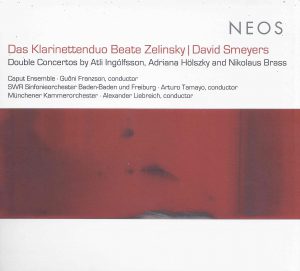 Double Concertos by Atli Ingólfsson, Adriana Hölszky and Nikolaus Brass. Das Klarinettenduo: Beate Zelinsky, clarinet; David Smeyers, clarinet; Caput Ensemble, Guðni Franzson, conductor; SWR Symphony Orchestra Baden-Baden and Freiburg, Arturo Tamayo, conductor; Munich Chamber Orchestra, Alexander Liebreich, conductor. A. Ingólfsson: Orgoras Speaks; A. Hölszky: Flugmanöver; N. Brass: Zeit im Grund. NEOS Music NEOS 11708. Total time 65:12. Amazon and iTunes
Double Concertos by Atli Ingólfsson, Adriana Hölszky and Nikolaus Brass. Das Klarinettenduo: Beate Zelinsky, clarinet; David Smeyers, clarinet; Caput Ensemble, Guðni Franzson, conductor; SWR Symphony Orchestra Baden-Baden and Freiburg, Arturo Tamayo, conductor; Munich Chamber Orchestra, Alexander Liebreich, conductor. A. Ingólfsson: Orgoras Speaks; A. Hölszky: Flugmanöver; N. Brass: Zeit im Grund. NEOS Music NEOS 11708. Total time 65:12. Amazon and iTunes
This album by Beate Zelinsky and David Smeyers, together known as Das Klarinettenduo, is a challenging yet rewarding collection of three double concertos that explore the possibilities of spectralism in concert works for clarinet. Accompanying the recording is a wonderfully detailed collection of liner notes written by Ingo Dorfmüller in German, English and French. These include program notes for each work
as well as composer, performer and ensemble biographies.
Spectralism, most commonly associated with the French composers Gérard Grisey, Tristan Murail, and other members of the Ensemble l’Itinéraire, is a compositional technique whereby pitch material and formal characteristics are determined by analyzing the harmonic spectrum of specific pitches or sounds.
Orgoras Speaks, the album’s first work, is according to the composer Atli Ingólfsson based “entirely on dyads of pitches… The so-called difference tone of all the pitches in the first part is the same, a virtual deep tone which then actually appears.” Directing the evolution of these dyads are the bright and energetic lines of Zelinsky and Smeyers. Nearly always in rhythmic unison, but never in pitch unison, the clarinetists brashly weave in and out of the ensemble texture.
The idea of the sound mass, often associated with the predecessors of spectralism such as Ligeti or Xenakis, is integral to spectral music. Sketches by Adriana Hölszky (included in the liner notes) that accompany her work Flugmanöver (Flight Maneuver) serve as a visual analogy to the sound masses she uses. The first sketch shows “an amorphous surface divided into three parts,” which are “lines, waves and points: they represent the instrumental groups – winds, percussion and strings.” In a relationship similar to Orgoras Speaks, these three instrumental groups both introduce motivic material and respond to the solo clarinetists. Hölszky differs in her treatment of the clarinetists, however. Whereas Zelinsky and Smeyers move with each other to create a unified line in Orgoras Speaks, here in Flugmanöver they move independently through similar gestural material, leading to moments of bitter conflict and surprising reconciliation.
Concluding the album is a 37-minute double concerto by Nikolaus Brass titled Zeit im Grund (Time Grounded). As is implied by the title, this work explores temporal flow within music as it relates to motivic repetition and development. Brass’s selected motives have been stripped bare: single repeated pitches, a repeated leap of a seventh, and clashing minor seconds between the basset horn and bass clarinet of Zelinsky and Smeyers. Slowly, these simple motives swirl and circle around each other, combine, break up and reform. At about the 25-minute mark, the music reaches critical mass and explodes with violent glissandi in the strings while the clarinetists smear and trill in their altissimo. Over the final 12 minutes of the piece, the music continues to unwind and relax, like a taut rubber band snapping back into its original relaxed state. In a final spectral farewell to the listener, the soloists conclude this work suspended in a lingering major second that fades into silence.
In sum, this is a well-executed album, with a diverse yet complementary selection of spectral repertoire and informative
liner notes, which should be most helpful to those who are interested in spectral music for clarinet but may be unsure where to begin.
– Derek Emch
 A Touch of Britain. Anna Hashimoto, clarinet; Rikuya Terashima, piano. W. Hurlstone: Four Characteristic Pieces; J. Horovitz: Sonatina and Two Majorcan Pieces; H. Howells: Sonata; C.V. Stanford: Three Intermezzi; W. Alwyn: Sonata. Fontec FOCD9756. Total time 76:00. www.annahashimoto.com and www.cdjapan.co.jp
A Touch of Britain. Anna Hashimoto, clarinet; Rikuya Terashima, piano. W. Hurlstone: Four Characteristic Pieces; J. Horovitz: Sonatina and Two Majorcan Pieces; H. Howells: Sonata; C.V. Stanford: Three Intermezzi; W. Alwyn: Sonata. Fontec FOCD9756. Total time 76:00. www.annahashimoto.com and www.cdjapan.co.jp
Anna Hashimoto was born in Japan but has spent much of her life in England. She studied clarinet at the Junior Department of the Royal College of Music (with Charles Hine), the Purcell School, and the Royal Academy of Music (with Michael Collins). She has received a plethora of prizes and awards, has performed with many distinguished orchestral conductors and chamber musicians, and was a featured artist at ClarinetFest® 2017. Collaborative pianist Rikuya Terashima was also born in Japan and has an impressive career. In addition to his fine pianistic performance, he has conducted, composed, and planned concerts.
William Hurlstone’s (1876-1906) Four Characteristic Pieces for clarinet and piano is a gem! What a shame his life was not longer. The piece is not difficult, but very lyrical, and can be enjoyed in a first hearing. The technique of both performers is solid as they capture the mood of the music. Of interest is the second movement which is titled “Croon Song.” Here the clarinet supplies delicate arpeggios over the piano lines. The third movement is cute, playful and tastefully rendered.
Joseph Horovitz’s Sonatina for clarinet and piano has become very popular. It is basically tonal and has a traditional format. The first movement is performed effortlessly with an imaginative interpretation. The next has the piano murmuring with flowing lines from the clarinet. The last movement can be quite difficult if taken at the indicated tempo. This is not a problem for Hashimoto and Terashima, who perform with panache and as a true duo. They pay careful attention to dynamic colors and they have an uncanny ability to control balance.
Two Majorcan Pieces, also by Horovitz, are for clarinet and piano. The composer writes that “‘Paguera’ is gentle and leisurely and ‘Valdemosa’ is a fast, whirling dance, punctuated by characteristic cross rhythms.” These are played as folk tunes and the style is excellent.
In Herbert Howells’ Sonata, the first movement reflects the darkness of war and death. The second movement is brisk but sinister. I do not sense the moods as being heavy enough, but this is likely due to the nature of the composition. The second movement offers a challenge to the clarinetist, but again Hashimoto delivers with considerable acumen.
Charles Villiers Stanford’s Three Intermezzi were composed early in his illustrious career. From the liner notes: “Elegant and romantic in style, each movement stands alone as poetic gems in the clarinet repertoire.” The performers choose excellent tempos and demonstrate technical facility. In the second movement, the piano and clarinet do a balancing act. The third movement is perky.
William Alwyn’s Sonata for Clarinet and Piano is not as well known as the others on this disc. The composer writes, “my sonata abandons the conventional three or four movement work for one in a single movement and so is in the nature of a fantasy-sonata full of dramatic contrasts but unconfined by strict, formal design.” It is more difficult and the moods change suddenly and frequently.
Both performers are true artists. The technique is superb, the intonation excellent, the musicality is as good as it gets, and the ensemble is superior. Highly recommended!
– Robert Chesebro
Music from the Islands. Jože Kotar, clarinet; Luca Ferrini, piano. R.R. Bennett: Ballad in Memory of Shirley Horn. K. Blak: Svínoy; J. Vella: Passacaglietta; J. Nordal: Ristur; C.S.L. Parker: The Ice Melt; S. Reade: Songs for Clarinet and Piano; M. Tally: Warm Life at the Foot of the Iceberg; T. Yoshimatsu: 4 Pieces in Bird Shape. Tutl FKT068. Total time 62:52. Amazon and iTunes
Kristali (Crystals). Jože Kotar, clarinet; Luca Ferrini, piano. Z. Vauda: Sonata brevis; N. Firšt: Atelje; C.S. Voglar: Kristali; V. Avsec: Koncertantni utrip; D. Bavdek: Geste mrtvega časa; S. Vremšak: Rondo; M. Mlakar: Metulj; I. Štuhec: Sedem anekdot; T. Habe: Tako in tako. Editions DSS 2017112. Total time 74:17. www.dss.si
The outstanding Slovenian clarinetist Jože Kotar, professor of clarinet at Ljubjana Academy of Music and principal clarinetist of the RTV Slovenia Symphony Orchestra, is featured, with his pianist collaborator Luca Ferrini, in two excellent new recordings.
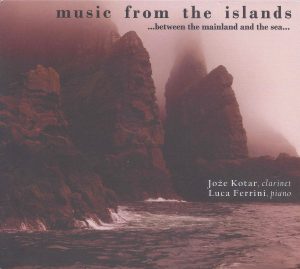 Music from the Islands posits the idea of “island culture” as an alternative to the increasing homogeneity of our planet brought on by the internet. An island, due to natural or enforced isolation, can engender its own unique musical and cultural identity, and these qualities are worthy of exploration. Every track on this new recording contains recent music written for clarinet and piano by island dwellers.
Music from the Islands posits the idea of “island culture” as an alternative to the increasing homogeneity of our planet brought on by the internet. An island, due to natural or enforced isolation, can engender its own unique musical and cultural identity, and these qualities are worthy of exploration. Every track on this new recording contains recent music written for clarinet and piano by island dwellers.
The recording begins with a performance of one of the finest works written for clarinet and piano in recent years, Richard Rodney Bennett’s Ballad in Memory of Shirley Horn (2005). This evocative piece, an homage to the great jazz singer, is given a first-rate performance, notable for creamy legato and excellent control.
The Faroe Islands is an archipelago of 18 islands with a population of around 50,000 situated halfway between Norway and Iceland. Kristian Blak (b. 1947), who resides there, is represented with the world-premiere recording of his Svinoy. Its declamatory opening is followed by a ruminative, introspective section that gathers strength through the repetition of short lyric motifs passed from clarinet to piano and back, with elegant passage work leading to an elegiac coda. Despite considerable dissonance, this fascinating piece retains a singing quality throughout.
Joseph Vella (1942-2018), who lived on Malta, the island in the Mediterranean south of Sicily, composed Passacaglietta, or “little passacaglia.” True to the form of a passacaglia, the piano plays a theme that is repeated throughout, over which the clarinet sings a melody. As the piece unfolds, the piano theme is eventually taken over by the clarinet in a satisfyingly dramatic way. There is palpable forward thrust and suppressed excitement in this short work.
The Icelandic composer Jon Nordal (b. 1926) has written Ristur (Carvings), a compellingly severe, dark work comprised of three short movements. In the first, wandering clarinet lines of a mournful nature are punctuated by dramatic piano chords; the second movement is more rhythmically incisive, beginning with an extended piano solo and including some flutter tonguing for the clarinetist; and the third movement is the most warmly lyrical and atmospheric of the three.
C.S.L. Parker (b. 1961), from Ireland, is given a world premiere of his six-minute piece, The Ice Melt. Beginning with a dead-on depiction of drips of water falling from ice, this lyrical piece, with gorgeous harmonic textures and a hint of improvisation, is well served by the performers’ ardent intensity.
Another world premiere is given to Simon Reade’s Songs for Clarinet and Piano. Reade (b. 1977) hails from Tasmania, the island located off the southern coast of Australia. Four songs are presented here: “In Edinburgh,” with its somber interior landscape; “Elegos I,” a movement for clarinet alone with hypnotic repeated figures; “To the Color Brown,” a lyrical song that becomes increasingly emphatic; and “Lullaby for Callum,” with its subtle swinging rhythm and melancholy turn of phrase.
Mirjam Tally (b. 1976) lives on Gotland, Sweden’s largest island, located in the Baltic Sea. Warm Life at the Foot of the Iceberg is given a world premiere recording here. This imaginative piece uses special effects in the piano and clarinet (multiphonics, pitch bending, flutter tonguing) to depict a universe of sound and activity, including bird calls, rustlings and animal voicings.
The Japanese composer Takashi Yoshimatsu (b. 1953) is represented by his lighthearted, attractive Four Pieces in Bird Shape. The four titles are: “Ballade,” “Invention,” “Recitativo,” and “Divertimento,” the first letters of which spell out the bird in question. These pieces require considerable technical prowess, rhythmic incisiveness, and perfect control of the highest range, and Kotar and Ferrini meet all challenges with ease.
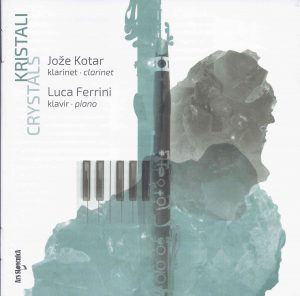 Jože Kotar’s Kristali (Crystals) explores mostly recent music composed by Slovenian composers, some of whom have dedicated their works to him. The varied repertoire on this disc, although unfamiliar to most of us, is of high quality, and the performers are to be congratulated for researching this music and bringing it to a wider audience.
Jože Kotar’s Kristali (Crystals) explores mostly recent music composed by Slovenian composers, some of whom have dedicated their works to him. The varied repertoire on this disc, although unfamiliar to most of us, is of high quality, and the performers are to be congratulated for researching this music and bringing it to a wider audience.
Zlatan Vauda (1923-2010) was an esteemed composer, educator and conductor in the former Yugoslavia. His Sonata Brevis, from 1952, is composed in the neoclassical style. Although short (about 11 minutes), this likeable sonata has big ideas, infectious energy, and easily remembered melodies. It deserves a wide audience, and could be chosen for a program as an alternative to the often-performed Poulenc Sonata.
Nenad First (b. 1964) composed Atelier in 2014 as a tribute to the series “Concert Atelier,” organized by the Society of Slovene Composers, which has presented new works by Slovenians for almost five decades. Dedicated to Kotar and Ferrini, and less tonal than some other pieces on this recording, Atelier is an intensely theatrical, imaginative dialogue between clarinet and piano.
Crt Sojar Voglar (b. 1976) wrote the expressive Kristali in 2013. It is in three parts: Fluido, Larghetto comodo, and Allegretto – Adagio calmo. Its wide-ranging harmonic language is reminiscent of Messiaen (especially in parts two and three), and it incorporates pitch bends and forays into the altissimo register.
Vitja Avsec (b. 1970) wrote Concertante Pulse in 2014. This four-minute neoclassical
gem opens with a declamatory section that develops into dramatic interplay between clarinet and piano, followed by a moment for clarinet alone before a chordal summing up with both instruments. Despite considerable variety of texture and expression, the listener gets the impression of one long, intense phrase.
The Gestures of a Dead Era, composed in 2013 by Dusan Bavdec (b. 1972), is an energetic, complex interplay between both instruments, with considerable technical and rhythmic demands. An insistently-repeated octave in the piano ends the piece dramatically.
Lasting a little over three minutes, Rondo, by Samo Vremsak (1930-2004), is a neoclassical miniature. Sunny, uncomplicated and straightforward, it uses the musical technique of a circular return to the same idea; here, it is embellished every time it reappears.
The jazz-influenced, whimsical Butterfly was composed in 2014 by Marijan Mlakar (b. 1966). An introspective opening gathers strength and culminates in a vigorously sustained altissimo A. The contrasting imitative section that follows leads to an extended clarinet riff before a reprise of some interplay between clarinet and piano.
Igor Stuhec’s (b. 1931) Seven Anecdotes (1955-1964) is a set of homages to eight masters: Debussy, Bartók, Prokofiev, Kogoj, Hindemith, Osterc, Slavenski and Webern. One homage is dedicated to two composers: Osterc and Slavenski. The homages tend to begin in the style of the selected composer, and then veer away into subjective reflections.
Tomaz Habe (b. 1947) notes that This Way and That Way, composed in 2013, is centered on the gesture of the tango.
This romantic, open-hearted work unfolds as a series of freely arranged variations on a theme.
Kotar and his splendid collaborator, pianist Luca Ferrini, have been performing together for more than 15 years, and the depth of their musical bond is everywhere apparent. They achieve perfect balance and clarity throughout both recordings. Kotar’s mastery of the clarinet is complete: beautiful sound, flawless technique, perfect rhythm, and highly expressive playing. Strongly recommended.
– Larry Guy
 Brahms Clarinet Sonatas & Piano Pieces. Nicolai Pfeffer, clarinet; Felix Wahl, piano. J. Brahms: Sonatas for Clarinet and Piano, Op. 120, Nos. 1 & 2 and Four Piano Pieces, Op. 119. Avi Music AVI 8553394. Total time 56:50. Amazon and iTunes
Brahms Clarinet Sonatas & Piano Pieces. Nicolai Pfeffer, clarinet; Felix Wahl, piano. J. Brahms: Sonatas for Clarinet and Piano, Op. 120, Nos. 1 & 2 and Four Piano Pieces, Op. 119. Avi Music AVI 8553394. Total time 56:50. Amazon and iTunes
Highly regarded German clarinetist and pedagogue Nicolai Pfeffer is on the faculty of the Grünwald School of Music (Munich); Cologne University of Music; Hanover University of Music, Drama and Media; Bremen University of Arts, and Lars Vogt’s ECHO-prize awarded “Rhapsody in School.” Pfeffer studied at the Cologne University of Music under Ralph Manno, and Indiana University in Bloomington with Howard Klug. Additionally, Pfeffer studied with Bruce Edwards, Sharon Kam, Werner Schwenk and Jochen Seggelke.
Pianist Felix Wahl studied with Bonn pianist Rose Marie Zartner and graduated cum laude from the Cologne University of Music in the studio of Pavel Gililov. Wahl has been a frequent performer at prestigious festivals and concerts throughout Germany.
Featuring the Brahms Sonatas, Op. 120, as well as the Four Piano Pieces, Op. 119, Pfeffer and Wahl’s performance engages the listener from beginning to end. Written by Pfeffer, Gililov and Michael Bryant, the album program notes lend great insight to the passion and history behind these masterworks.
Throughout the sonatas, Pfeffer and Wahl’s spirited performance presents great contrast in dynamics, colors, nuance and passion. Pfeffer negotiates wide leaps with great ease, elegance and control and Wahl proves a master collaborator, always perfectly balanced with the clarinet.
The liner notes state of the Four Piano Pieces, Op. 119, “Placed between the two monumental sonatas which are formed through intense dialogues, the monologic piano intermezzi offer the listener a breather for introspection.” Wahl’s performance of these pieces is elegant and charming, providing great contrast to the clarinet sonatas.
Pfeffer and Wahl’s passionate performance of the Brahms Sonatas and Piano Pieces is a must have for your library.
– Julianne Kirk Doyle
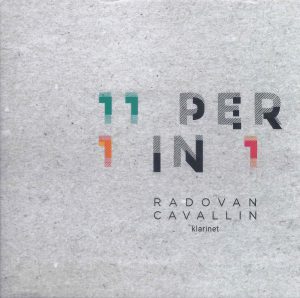 11 per 1 in 1. Radovan Cavallin, clarinet; M. Elezović, piano. B. Kunc: Pastoral Fantasy; A. Klobučar: Monologue; A. Šaban: Elegy, Rondo, Reminiscence of Elegy and Reminiscence of Rondo; D. Detoni: 11 per 1 in 1; M. Paar: Little Christmas Fantasy and Little Christmas Fantasy for Two; E. Cossetto: Obrati u Scherzu; A. Grgin: Capriccio No. 1. Aquarius Records CD 614-17. Total time 52:50. Amazon and iTunes
11 per 1 in 1. Radovan Cavallin, clarinet; M. Elezović, piano. B. Kunc: Pastoral Fantasy; A. Klobučar: Monologue; A. Šaban: Elegy, Rondo, Reminiscence of Elegy and Reminiscence of Rondo; D. Detoni: 11 per 1 in 1; M. Paar: Little Christmas Fantasy and Little Christmas Fantasy for Two; E. Cossetto: Obrati u Scherzu; A. Grgin: Capriccio No. 1. Aquarius Records CD 614-17. Total time 52:50. Amazon and iTunes
Radovan Cavallin’s new recording 11 per 1 in 1 is a fascinating collection of pieces that explore works by composers of his native Croatia. Born in Zagreb, Cavallin entered the Academy of Music at the University of Zagreb at only 13 years old, becoming the youngest student ever admitted in the university’s history. In 1986, he entered the Paris Conservatory, where he graduated in the class of Guy Deplus. Cavallin has performed over
400 solo concerts and is currently principal clarinet of the Gran Canaria Philharmonic Orchestra.
In 11 per 1 in 1, Radovan celebrates solo repertoire for the clarinet that spans 60 years of Croatian musical tradition. The first piece, Božidar Kunc’s Pastoral Fantasy (1957), is a rhapsodic unaccompanied piece that highlights Cavallin’s effortless tone and beautiful rendering of phases. The capricious opening gives way to brilliant, folk-like melodies peppered with staccato interjections. The piece advances to a blazing stop that Cavallin delivers with virtuosic agility and dramatic flair.
The intensity of the final notes of Pastoral Fantasy contrasts beautifully with the quiet opening of Anđelko Klobučar’s Monologue. This soliloquy for clarinet is contemplative at times and bursts forth suddenly at others. Cavallin’s stirring sotto voce playing contrasts gracefully with the frenetic intensity of the forte sections.
The next four pieces are composed by Antun Tomislav Šaban, who also produced the album. Šaban’s Elegy and Rondo includes piano accompaniment, performed by Mia Elezović. Of particular note in this piece is Radovan’s lingering presence and taper at the end of each phrase. Rondo is a delightful contrast to Elegy, with a carefree sensibility, driving momentum and coquettish virtuosity. Radovan and Elezović’s well-matched staccato playing is particularly enjoyable.
Šaban’s next two pieces, Reminiscence of Elegy and Reminiscence of Rondo, are unaccompanied and indeed recall the pieces that precede them. Although not mentioned in the liner notes, Aquarius Records’ website yielded that the composer wrote the Reminiscences 29 years after he composed the original pieces in 1988. The Reminiscence of Elegy is much shorter than its namesake and has a longing quality that drives the music forward with bubbling motives and tremolos. Similarly, Reminiscence of Rondo flows freely and makes use of Cavallin’s impressive altissimo playing. Speckled throughout the piece are pointillistic sections that slow dramatically and give the listener the feeling that Cavallin is walking away. The effect is charming and allows the listener to feel as though they are watching a live concert.
The title track, 11 per 1 in 1 by Dubravko Detoni, was dedicated to Cavallin in 1983, when he was only 14 years old. This unaccompanied piece showcases Cavallin’s effortless virtuosity and utilizes extended techniques such as flutter tonguing while singing. The middle section of this piece features a legato motive that repeats in a hypnotic manner, made impossibly smooth by Cavallin’s use of circular breathing.
The next piece is a fun departure – if not a bit surprising – from what has been offered thus far. Clarinetist and composer Mihael Paar’s Little Christmas Fantasy is a witty and humorous take on the classic Jingle Bells. This piece will surely make the rounds in many a holiday concert to come. As a bonus, the last track is a version of Little Christmas Fantasy for two clarinets, both tracks recorded by Cavallin.
Next, Emil Cossetto’s Obrati u Scherzu for unaccompanied clarinet is a colorful, driving scherzo that is a delight to listen to. The album’s final piece is clarinetist and composer Ante Grgin’s Capriccio No. 1. This piece alternates between free, lugubrious musings in Cavallin’s beautiful chalumeau range and driving melodies and scales in 7/8. Cavallin’s commanding performance of this piece creates a fantastic flourish at the end of this wonderful album.
11 per 1 in 1 is a well-crafted and well-produced curation of Croatian clarinet repertoire. This album will certainly serve as a staple reference recording for anyone who is interested in performing these valuable Croatian pieces.
– Anna Roach
 A Garland for John McCabe. Linda Merrick, clarinet; John Turner, recorder; Alistair Vennart, viola; Peter Lawson, piano. P. Dickinson: A Rag for McCabe; J. Joubert: Exequy; E. Gregson: John’s Farewell; R. Saxton: A Little Prelude for John McCabe; H. Skempton: Highland Song; E. Pehkonen: Lament for the Turtle-Dove; R. Walker: And Will You Walk Beside Me Down the Lane?; M. Lipkin: In Memoriam John McCabe; W. Marshall: Little Passacaglia; M. Ellerby: Nocturnes and Dawn (Patterdale); R. Keeley: Elegy for John McCabe; J.F. Brown: Evening Changes; G. Schurmann: Memento; A. Gilbert: The Flame has Ceased; C. Gunning: Danse des Fourmis; D. Matthews: Chaconne; R. Warren: In Nomine; E. Howard: Outback; G. Carpenter: Edradour. Divine Art Records DDA 25166. Total time 79:35. Amazon, iTunes and www.divineartrecords.com
A Garland for John McCabe. Linda Merrick, clarinet; John Turner, recorder; Alistair Vennart, viola; Peter Lawson, piano. P. Dickinson: A Rag for McCabe; J. Joubert: Exequy; E. Gregson: John’s Farewell; R. Saxton: A Little Prelude for John McCabe; H. Skempton: Highland Song; E. Pehkonen: Lament for the Turtle-Dove; R. Walker: And Will You Walk Beside Me Down the Lane?; M. Lipkin: In Memoriam John McCabe; W. Marshall: Little Passacaglia; M. Ellerby: Nocturnes and Dawn (Patterdale); R. Keeley: Elegy for John McCabe; J.F. Brown: Evening Changes; G. Schurmann: Memento; A. Gilbert: The Flame has Ceased; C. Gunning: Danse des Fourmis; D. Matthews: Chaconne; R. Warren: In Nomine; E. Howard: Outback; G. Carpenter: Edradour. Divine Art Records DDA 25166. Total time 79:35. Amazon, iTunes and www.divineartrecords.com
John McCabe (1939-2015) was a distinguished English pianist, composer and writer on music. His compositional output was sizable, specializing in concerti and chamber music. There was a special affinity for the clarinet in his catalog: no less than ten chamber works included clarinet, in addition to an unaccompanied piece and a clarinet concerto.
It is through this lens that we are appreciative of all the composers associated with A Garland for John McCabe, an anthology of tributes from 19 composers to the memory of McCabe. Of the 19 works on the album, 12 feature the clarinet. The instrumentation varies within the quartet of instruments: clarinet, recorder, viola and piano. None of the works are longer than 6 minutes and 20 seconds, excellent for inclusion on concerts of any length.
Peter Dickinson’s rag for the quartet is a charming minor-key take on the genre. The pieces on this album utilizing both recorder and clarinet prove to be a viable pairing, especially the low clarinet in octaves with the thinner recorder. Saxton’s Prelude is based on the upper case letters of McCabe’s name. The intricate counterpoint arrives at a satisfying conclusion. Highland Song by Howard Skempton, for recorder, clarinet and viola, evokes the Scottish soundscape of that region. A lovely clarinet soliloquy is followed by a pastoral trio. The clarinet and viola duet that concludes the piece is expertly wrought.
Elis Pehkonen’s Lament for the Turtle-Dove is based on one of his favorite medieval plainchant melodies, Benedicamus Domino. Inspired by the birds in and around Pehkonen’s garden, Lament is set as a theme and variations. This performance highlights delicate, crystalline piano playing, showcasing the contrasting shades of the ensemble. Lament is an exquisite piece and one of the highlights of the album. Robin Walker’s quartet is, in a sense, a prequel. The title is the opening question, answered by the melody of the 1930s song I’ll Walk Beside You. The viola and recorder combination lends itself to pastoral country scenes. This quartet evokes that spirit beautifully. In Memoriam John McCabe for clarinet, viola and piano by Malcolm Lipkin is the first work with clarinet on this album that incorporates a theme from a Haydn piano sonata. McCabe was the first pianist to record all of Haydn’s piano sonatas.
Rob Keeley’s Elegy for clarinet and piano is another tribute based on the letters of McCabe’s name. Angular and prickly, the clarinet attempts to soften the edges with some fine legato playing. The “changes” implied in James Francis Brown’s Evening Changes for recorder, clarinet and viola are primarily stylistic, with a medieval tinge leading to a more contemporary, cadenza-infused finale. Kudos to John Turner, recorder, for some excellent multiple articulation work.
Gunning’s Dance of the Ants for recorder, clarinet and piano is as bouncy and charming as its title. This piece is infused with a happy counterpoint brimming with sunshine. John Turner’s technical command on this piece is excellent, notably his ascending leaps. David Matthews’ Chaconne for clarinet, viola and piano is a peaceful meditation on McCabe’s life in music, as well as a fine addition to the terrific repertoire of clarinet, viola and piano.
Howard’s Outback, for recorder, clarinet, viola and piano, references the Australian landscape of which McCabe was so fond. Sparse, angular textures predominate. For those of us that enjoy single malt whiskies (and the rare bass clarinet sighting), Edradour for recorder, clarinet, viola and piano is right up our alley. Gary Carpenter serves up an energetic quartet in honor of one of McCabe’s favorite beverages.
Linda Merrick, noted recording artist and principal tutor at the Royal Northern College of Music in Manchester, performs splendidly. This album is a fitting remembrance for one of England’s finest musicians.
– Osiris J. Molina
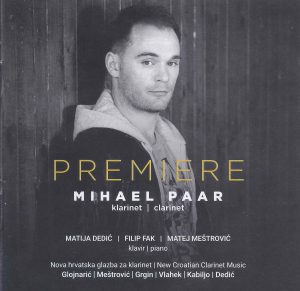 Premiere. Mihael Paar, clarinet; Filip Fak, piano; Matej Meštrović, piano; Matija Dedić, piano. S. Glojnarić: Igra mala – Concertino; M. Meštrović: Stars Over Budapest; A. Grgin: Capriccio No. 6; B. Vlahek: Sonata, Op. 42; A. Kabiljo: Srebena ptica; M. Dedić: Rhapsodietta. Cantus 98898495792. Total time 47:57. Amazon, iTunes and www.cantus.hr
Premiere. Mihael Paar, clarinet; Filip Fak, piano; Matej Meštrović, piano; Matija Dedić, piano. S. Glojnarić: Igra mala – Concertino; M. Meštrović: Stars Over Budapest; A. Grgin: Capriccio No. 6; B. Vlahek: Sonata, Op. 42; A. Kabiljo: Srebena ptica; M. Dedić: Rhapsodietta. Cantus 98898495792. Total time 47:57. Amazon, iTunes and www.cantus.hr
Croatian clarinetist Mihael Paar has prepared his debut recording featuring music composed by several of his compatriots. The works were written and premiered between 2015 and 2017, so all of them are refreshingly recent. Most are short; even Burno Vlahek’s Sonata, the most substantial piece on the disc, runs less than 18 minutes. The works are also unabashedly tonal, and therefore accessible for a wide range of listeners.
The three-movement set that opens the disc, Little Game, is a cheerful work with shades of jazz style – not surprising, since the composer, Silvije Glojnarić, has been a well-known jazz performer and bandleader in Croatia for many years. Stars Over Budapest was originally written for clarinet and string orchestra as part of a documentary film, and the composer rearranged it for piano accompaniment especially for this recording. By contrast with Little Game, this brief piece is slow and more serious, with a tinge of melancholy and a hint of Romani coloring in its lyrical melody. The composer of Capriccio No. 6, Ante Grgin, is himself a well-known clarinetist in Croatia, as former principal of the Belgrade Philharmonic. The Capriccio reflects some of his abiding musical interests, namely, “jazz, oldies and chansons,” as he states in the liner notes. In form a rondo, the main theme is slow in tempo and cantabile in character, and is varied every time it is repeated. The contrasting episodes contain plenty of technical challenges for the player, which Paar negotiates with smoothness and panache.
The three-movement Sonata by Bruno Vlahek recently won a Porin Award, a national award given by several Croatian music associations. It is a stylistically eclectic work. The first movement has a little hint of Hindemith in it. The second movement, quite contrasting in style, begins with a folk-like melody that eventually gives way to two further themes, one a little Spanish-sounding, the other waltz-like. These are developed in a kind of patchwork way before the original folk theme returns. The sprightly third movement closes the sonata with a catchy tune that ensures an enthusiastic audience response. The composer Alfi Kabiljo is well known in Croatia for his film scores, TV soundtracks, and musicals. His unaccompanied work Silver Bird was inspired by a sculpture of the same name. While not perhaps as coherently composed as the unaccompanied work discussed above, this is nevertheless an entertaining piece. The closer on the disc is Rhapsodietta by Matija Dedić, who is also active as a jazz and pop musician. These influences can be clearly heard in this short, but attractive work.
Croatian composers are lucky to have found an advocate in Mihael Paar, who plays with beautiful tone and technical ease, and who offers sensitive interpretations of their works. None of the compositions on this disc takes great musical chances, but they are all quite pleasant and could happily find a place on recital programs. The recording quality of this disc is good, and Paar is ably partnered by the pianist Filip Flak, and on two of the works (Meštrović and Dedić) by the composers themselves. The liner notes, written by Paar with generous quotes from the composers, are informative.
– Jane Ellsworth
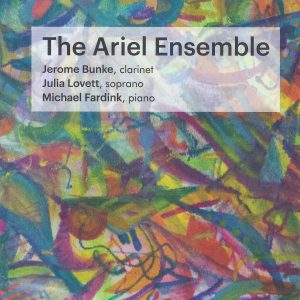 The Ariel Ensemble. Jerome Bunke, clarinet; Julia Lovett, soprano; Michael Fardink, piano. R. Lane: Elegy; A. Hovhaness: O Lady Moon, Op. 139; M. Garwood: Six Japanese Songs; K. Hoover: Selima, or Ode on the Death of a Favorite Cat, Drowned in a Tub of Gold Fishes; J. Gottlieb: Downtown Blues for Uptown Halls; R. Vaughan Williams: Three Vocalises; W. Mayer: Enter Ariel; J. Freeman: Elizabethan Love Songs; J. McCabe: Three Folk Songs, Op. 19. Clover Field Recordings CFR 5860. Total time: 54:05. www.digitalforce.com
The Ariel Ensemble. Jerome Bunke, clarinet; Julia Lovett, soprano; Michael Fardink, piano. R. Lane: Elegy; A. Hovhaness: O Lady Moon, Op. 139; M. Garwood: Six Japanese Songs; K. Hoover: Selima, or Ode on the Death of a Favorite Cat, Drowned in a Tub of Gold Fishes; J. Gottlieb: Downtown Blues for Uptown Halls; R. Vaughan Williams: Three Vocalises; W. Mayer: Enter Ariel; J. Freeman: Elizabethan Love Songs; J. McCabe: Three Folk Songs, Op. 19. Clover Field Recordings CFR 5860. Total time: 54:05. www.digitalforce.com
Works for clarinet and voice are deceivingly difficult to perform effectively, and doubly so to record. Duo and trio ensembles with clarinet and voice especially face challenges of balance, a task which the Ariel Ensemble of New York accepted in the ’80s. With their production team, it produced a marvelous collection of recordings. Several of these are first presented in this album, while several others appear to be migrated from previous vinyl recordings of the ensemble. This ensemble comprises three: Jerome Bunke, a New York-area clarinetist and president of production company Digital Force; Julia Lovett, a prominent soprano and frequent performer of new opera roles in the 1970s and ’80s; and the late Michael Fardink, a pianist and past director of opera at Rutgers. Critical acclaim of the Ariel Ensemble comes from such prominent publications as The New York Times, Musical America, and The Miami Herald.
The album’s first two works lay the groundwork for an intense commitment to balance and performative energy. Richard Lane’s Elegy and Alan Hovhaness’ O Lady Moon are short, deeply reflective works of deliberate tempi. Bunke and Fardink never overwhelm Lovett’s sensitive singing, permitting entire phrases to flow seamlessly to the listener. Next, Margaret Garwood’s haunting Six Japanese Songs draw from sets of text that are all exactly 17 syllables. The ensemble embraces quietude and careful deliberation, as demanded in all six of Garwood’s movements. I was particularly moved by the movement titled “Death Song,” with text by an anonymous writer. The full Garwood composition is easily consumed by listeners of all varieties, given the short length of each movement.
The energy shifts quickly at the start of Katherine Hoover’s Selima, or Ode on the Death of a Favourite Cat, Drowned in a Tub of Gold Fishes. This work contains more modern techniques for the clarinetist, including flutter tonguing, which Bunke accomplishes seamlessly. The work’s tonal language and expressions are quite dramatic. This work feels longer than 7 minutes, which is a testament to the level of engagement exhibited by the performers and the piece’s interesting construction. Lovett’s outlining of major and minor chords a capella with limited harmonic language to lean on is impressive.
Jack Gottlieb then contributes the album’s most flashy composition, Downtown Blues for Uptown Halls. Images of jazzy New York City are drawn from the lyrics and from the movement’s titles, particularly “Neon Night.” Balance is particularly outstanding in this work’s execution. Even at moments of high energy, or heightened dynamics (or both!), Lovett’s singing is not compromised by the other performers.
Vaughan Williams’ Three Vocalises are a well-known duo setting for clarinet and soprano. Bunke and Lovett work together delightfully here, interplaying seamlessly between one another. Professionals or advanced collegiate clarinetists would find great value in this recording if preparing for a performance of the Three Vocalises with a soprano colleague.
William Mayer’s song cycle Enter Ariel continues the album, a collection of five movements with text of various American poets, including Sara Teasdale, e.e. cummings, and Langston Hughes. Mayer recently passed away in 2017, making the inclusion of this wonderful song cycle a timely testament to his work. The movements are highly varied and do not always conclude in manners that are expected by the movement’s original momentum. The work’s ending is a surprising subtlety, for example, that is masterfully crafted by Bunke’s control of soft dynamics.
Though written in the 20th century, John Freeman’s Elizabethan Love Songs pay homage to the English Renaissance and the traditional Elizabethan song. The short length of the movements and more streamlined harmonic structure of the works provide an excellent educational opportunity for advanced students to perform the work. The ensemble makes no less of an effort for this more traditionally-structured work, as the careful layering of Bunke’s playing is never lost under Fardink, and both give way to Lovett whenever her lyrics are present.
With so many dark and deliberate moments found in the disc’s 54 minutes, one is led to wonder how the ensemble will conclude their album well before that point is reached. John McCabe’s Three Folk Songs, Op. 19, is energetic, upbeat and spritely. Listeners are sent away with a slight grin on their faces, particularly with the final movement “John Peel,” a play on colonial seafaring music. The album’s sequencing is masterful, bringing listeners through a journey of great intensity and reflection while concluding with this optimistic aesthetic. Highly recommended.
– Joel Auringer
Comments are closed.